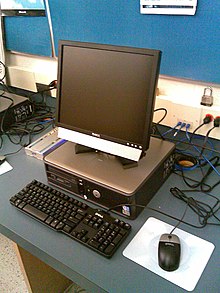Desktop computer
A desktop computer , or “desktop” for short ( borrowed from the English word for “desk” and top for “top”, ie a desk computer ) is a computer in a housing shape , suitable for use as a workstation computer on desks . The term is mostly used synonymously with desktop PC , i.e. personal computers are meant.
commitment
Businesses use desktops on a massive scale these days. The main reason for this is the dual usability. The modern desktops can be used lying down as well as standing, with this advantage one is flexible and can set up the desktop according to the given possibilities. Usually, the optical drives can then be installed either horizontally or vertically or rotated by 90 °. In addition, desktop computers are less easy to steal than notebooks.
history
The first freely programmable commercial desktop computer in the world was the " Programma 101 " by Olivetti from 1965; in the advertisement it is also referred to as a desktop computer for the first time in the literature (computer was a synonym for calculator at the time). From 1968 onwards, Hewlett-Packard produced the desktop computer HP-9100A , which was referred to as a personal computer in an advertisement for the first time in the literature, although it did not correspond to today's understanding of a PC in terms of price or technology. It cost around twice the average gross annual salary at the time. Since both devices do not have an alphanumeric display, they can be viewed as sophisticated programmable computers. In contrast to these two devices, the HP-9830 published in 1972 has a BASIC interpreter integrated in the ROM , so that it no longer has to be programmed in pure machine code ; Thanks to a full alphanumeric keyboard and its alphanumeric display, it bridges the gap between a conventional desktop computer and an all-in-one desktop computer. This device has only a single line of the screen with only 32 characters. In addition, it is hardly affordable for private households at US $ 5,975 (which corresponds to a value of US $ 36,434 in 2020). Nevertheless, it comes very close to today's understanding of the term personal computer and is therefore considered by some people to be the first desktop PC in the world.
Differentiation from other designs
The original demarcation between desktop computers and mini or midi towers, for example, is not clear today, as modern drives mean that the housing can be positioned standing or lying on the desk , as well as, as with midi towers or big towers , standing under the work table. Which variant is used in individual cases can be, for. B. be made dependent on the available space, the cable distribution and power access or simply the preference. Until about the end of the 1980s, the lying (“desktop”) variant on the desk was predominant, while in the course of the 1990s the tower variant became more and more popular. Some housings are set up for both uses and, for example, come with separate, optional feet for vertical positioning. However, depending on the design, CD / DVD drives can force a horizontal installation, as can some older hard disk models based on ball bearings that the manufacturer does not approve for vertical installation. In addition, from a technical point of view, it is irrelevant whether a housing is on or under a table as long as the fans are kept free.
Newer usage
Today, microcomputers with tower housings are also referred to as desktop computers, even if they are no longer on the desk, but under it. It is crucial that the microcomputer is located directly at the workplace. These desktop computers are thus separated from laptops and notebooks on the one hand and servers and workstations on the other.
If the actual computer and the monitor are combined in one housing (example: Apple iMac ), one speaks of an all-in-one computer .
Web links
Individual evidence
- ^ Wiktionary: de: desk ; probably related to the English word description , for " description "
- ↑ Wiktionary: de: top
- ↑ K. Dette, Olivetti Personal Computer for Teaching and Research , Springer, 1989
- ↑ Brennan, AnnMarie. "Olivetti: A work of art in the age of immaterial labor." Journal of Design History 28.3 (2015): 235-253.
- ↑ kuno.de: desktop computer
- ^ The new Hewlett-Packard 9100A personal computer , 1968, hp.com, accessed October 20, 2017; see also The First PC in Wired of December 8, 2000 (issue 12/2000) and The First PC , page 11, wired.com
- ↑ Hewlett-Packard HP 9830 Calculator , hp9830.com, quote: "The HP9830 may have been the first personal computer", accessed on October 13, 2017

